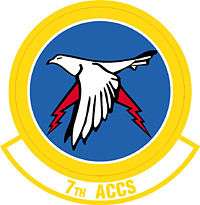7th Airborne Command and Control Squadron
| 7th Airborne Command and Control Squadron | |
|---|---|
|
7th Airborne Command and Control Squadron Patch | |
| Active |
24 March 1942 - 1 April 1944 1 May 1944 - 15 January 1946 18 October 1954 - 8 January 1966 13 February 1968 - October 1998 |
| Country | United States |
| Branch | United States Air Force |
| Type | Airborne Command and Control |
| Decorations |
|


The 7th Expeditionary Airborne Command and Control Squadron (7 EACCS) is part of the 379th Air Expeditionary Wing at Al Udeid Air Base, Qatar. It operates the E-8 Joint STARS aircraft, conducting airborne command and control missions.
History
The 7th ferried lend-lease aircraft to Alaska for turnover to Soviets from, June 1942–March 1944. It conducted aerial transportation in the Southwest and Western Pacific from, 13 December 1944–September 1945.
Reestablished in 1952 as a Headquarters. Air Force Logistics Command-controlled logistics squadron. Its mission was to provide world-wide airlift of nuclear weapons and related equipment, with a secondary mission to airlift other Department of Defense cargo as required when space was available. The squadron also provided airlift support during Cuban Missile Crisis from, 17 –28 October 1962. Inactivated in 1965 with inactivation of storage sites.[1]
Became a Military Air Transport Service (later Military Airlift Command) C-124 Globemaster II strategic transport squadron flying worldwide airlift operations. Inactivated with retirement of C-124 in 1966.
Reactivated in 1968 and performed Airborne Battlefield Command and Control (ABCCC) mission in Southeast Asia from, 1 March 1968 – 15 August 1973 and controlled airborne forces during the recovery of the SS Mayagüez in May 1975, in Grenada from, 23 October–21 November 1983, in Panama from, December 1989–January 1992, and in Southwest Asia from, 1 September 1990 – 16 March 1991.[1]
In 1994, the 7 ACCS was moved from Keesler AFB, Mississippi, to Offutt AFB, Nebraska where it transitioned from EC-130 aircraft flying the ABCCC mission to the EC-135 aircraft flying the Airborne Command Post (ABNCP) "Looking Glass" mission in support of nuclear command and control for United States Strategic Command.[2] In October 1998, the "Looking Glass" mission was transferred to the Navy's E-6 fleet, the last of the US Air Force's EC-135 fleet was retired, and the 7 ACCS was inactivated.
In March 2008, the unit was again reactivated - this time as the 7th Expeditionary Airborne Command and Control Squadron (7 EACCS) - to be the forward operating squadron for E-8 Joint STARS supporting the United States Central Command Area of Responsibility.
Lineage[1]
- Constituted 7th Air Corps Ferrying Squadron on 18 February 1942
- Activated on 24 March 1942
- Redesignated 7th Ferrying Squadron on 12 May 1943
- Disbanded on 1 April 1944
- Reconstituted on 19 September 1985
- Consolidated (19 September 1985) with: 7th Combat Cargo Squadron
- Constituted on 25 April 1944
- Activated on 1 May 1944
- Inactivated on 15 January 1946
- Disbanded on 8 October 1948
- Reconstituted on 19 September 1985 as 7th Air Transport Squadron, Special
- Constituted 7th Logistics Support Squadron on 22 June 1954
- Activated on 18 October 1954
- Redesignated 7th Air Transport Squadron, Special, on 1 July 1964
- Discontinued, and inactivated, on 8 January 1966
- Constituted as 7th Airborne Command and Control Squadron and activated, on 13 February 1968
- Organized on 1 March 1968
- Inactivated on 1 October 1998.
- Redesignated 7th Expeditionary Airborne Command and Control Squadron and converted to provisional status on 4 December 2001
Assignments[1]
- North West Sector, Ferrying Command (later, 7th Ferrying Group), 18 February 1942 – 1 April 1944
- 2d Combat Cargo Group, 1 May 1944 – 15 January 1946
- Warner Robins Air Materiel Area, 18 October 1954
- 3079th Aviation Depot Wing, 6 February 1955
- 39th Logistics Support Group, 1 July 1962
- 62d Troop Carrier Wing, 1 July 1963
- 63d Troop Carrier Wing, 1 July 1964 – 8 January 1966
- Pacific Air Forces, 13 February 1968
- Seventh Air Force, 1 March 1968
- 432d Tactical Reconnaissance Wing, 31 October 1968
- Attached to Seventh Air Force, 31 October 1968–
- 388th Tactical Fighter Wing, 30 April 1972
- Remained attached to Seventh Air Force to 15 August 1973
- Attached to US Support Activities Group/Seventh Air Force, 15 August 1973–c. 21 May 1974
- 374th Tactical Airlift Wing, 22 May 1974
- Attached to Thirteenth Air Force, 22 May 1974–
- 3d Tactical Fighter Wing, 31 March 1975
- Remained attached to Thirteenth Air Force to 14 August 1975
- 507th Tactical Air Control Group, 14 August 1975
- 552d Airborne Warning and Control Wing (later, 552d Airborne Warning and Control Division), 1 October 1976
- 28th Air Division, 1 April 1985
- Attached to Air Division Provisional, 15, 5 December 1990–c. 16 March 1991 (See Organization of United States Air Force Units in the Gulf War)
- 552d Operations Group, 29 May 1992
- 55th Operations Group, 19 July 1994 – 1 October 1988
- Air Combat Command to activate or inactivate any time after 4 December 2001
- Attached to: 379th Air Expeditionary Wing, Undetermined dates
Stations[1]
|
|
Aircraft[1]
- C-47 Skytrain (1944–1945)
- C-46 Commando (1944–1945)
- C-124 Globemaster II (1954–1966)
- EC-130 ABCCC (1968–1994)
- EC-135 ABNCP (1994–1998)
- E-8C JSTARS (??? - Present)
Operations[1]
- World War II
- Vietnam War
- Operation Urgent Fury
- Operation Just Cause
- Operation Desert Storm
- Operation Deny Flight
- Operation Deliberate Force
- Operation Decisive Endeavor
- Operation Uphold Democracy
- Operation Iraqi Freedom
- Operation Enduring Freedom
References
Notes
- 1 2 3 4 5 6 7 AFHRA 7 ACCS Page
- ↑ "Factsheets : 7 Expeditionary Airborne Command and Control Squadron (ACC)". Air Force Historical Research Agency. 2010-06-24. Retrieved 2014-02-08.
